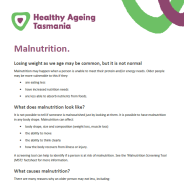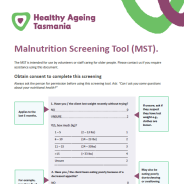
Malnutrition screening
Help to prevent and reduce malnutrition in older people who live at home.
Please note
The information on this website is for general information and educational purposes only. If you have any health concerns or think you are at risk of malnutrition, talk to your GP.
Malnutrition
Malnutrition in older people means ‘under-nutrition’. This may happen when a person is unable to meet their energy and or protein needs.
Malnutrition can affect an older person’s:
- body shape, size and composition (weight loss, muscle loss)
- ability to move
- ability to think clearly
- recovery from illness or injury.
Older people may be more vulnerable to malnutrition as they may:
- eat less
- have increased nutrition needs
- be less able to absorb nutrients from foods.
There are many reasons why older people may eat less food.
These include:
- poor appetite
- limited access to food
- difficulty cooking (eg carrying heavy saucepans, opening packets, using sharp knives)
- cost of food
- social isolation or loneliness
- limited cooking skills
- difficulty feeding themselves (eg using a knife and fork)
- problems chewing or swallowing
- reduced taste or smell
- less mobile (eg trouble standing for periods of time).
How to spot malnutrition
We can’t tell if someone is malnourished just by looking at them.
A screening tool is the only way to identify if a person is at risk of malnutrition.
Screening tools do not diagnose malnutrition. This can be done by an Accredited Practising Dietitian.
Malnutrition Screening
The Malnutrition Screening Tool (MST) is simple to use and only has two questions.
Each question gets a score. The final score indicates the level of malnutrition risk: low, moderate, or high.
With training, staff and volunteers can use the MST with older people who live at home.
Watch this video of the Malnutrition Screening Tool in practice
Next steps
Ask the Nutrition risk identification questions
These questions help to uncover any issues (red flags) that are contributing. You can then address any issues and find ways to support them.
If they are at ‘high risk’ of malnutrition, talk to them about a referral to see their GP or Accredited Practising Dietitian, as well as helping to address the identified issues.
Watch this video of the Nutrition risk identification questions in practice
Supporting someone with malnutrition
Here are some ideas to improve their nutrition if they are eating less than usual:
- start with the protein food first (eg meat, eggs)
- eat the biggest meal when feeling hungriest
- if struggling to eat large meals; have smaller meals, but more of them over the day
- sip on drinks that are higher in energy (eg milk drink)
- eat with other people wherever possible
- have plenty of favourite foods on hand.
How to access an Accredited Practising Dietitian
Accredited Practising Dietitians provide one-on-one nutrition counselling and support.
Support for community aged care workers and volunteers
Contact the Healthy Ageing Tasmania dietitians for advice, support and training.[email protected]




